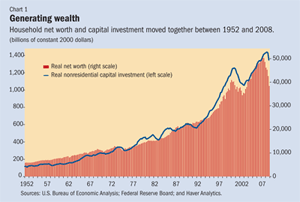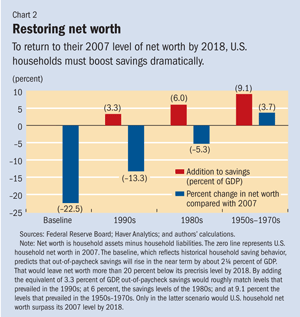Rebuilding U.S. Wealth
Finance & Development, December 2009, Volume 46, Number 4
A world that frets about lost consumer demand should also worry whether newly frugal U.S. households will save enough
U.S. CONSUMERS, once the driving force behind world prosperity, are buying less and saving more in the aftermath of a global financial crisis that wiped out a big chunk of their wealth.
After saving almost nothing from their paychecks for a number of years, U.S. consumers may have permanently changed their behavior, many economists and others think. Policymakers and economists around the world are concerned that the shortfall in global demand caused by the newly tightfisted U.S. consumer portends a sluggish global recovery. The spending gap will not be bridged by consumers from other countries, such as China, or additional capital investment, at least not in the near term, they believe.
But there is another side to the story. Although the global concern about replacing lost U.S. demand is real, for the United States itself the worry might rather be whether households will be frugal enough. Consumers can rebuild their wealth (that is, net worth—the difference between assets and liabilities) only by letting their savings accumulate.
Wealth and investment
 Household wealth building is critical to a related concern: capital investment. Net worth and capital expenditures appear to be closely linked (see Chart 1). This striking correlation may be explained by the effect of the so-called financial accelerator: firms with stronger balance sheets can borrow (and finance capital expenditures) on more favorable terms. During periods of financial distress, when credit is scarce and corporate earnings are low, new household savings appear to be the most likely source of funds for firms seeking to replenish their balance sheets.
Household wealth building is critical to a related concern: capital investment. Net worth and capital expenditures appear to be closely linked (see Chart 1). This striking correlation may be explained by the effect of the so-called financial accelerator: firms with stronger balance sheets can borrow (and finance capital expenditures) on more favorable terms. During periods of financial distress, when credit is scarce and corporate earnings are low, new household savings appear to be the most likely source of funds for firms seeking to replenish their balance sheets.
Sustainable growth requires new capital formation. While rising overall demand (including consumption) may be a precondition for a recovery in capital investment, as traditional theories of investment tell us, weak balance sheets may dampen that recovery. Unless capital gains and corporate earnings are as strong as they were in the bubble years before the crisis, an unlikely prospect, firms will not be able to generate sufficient investment funds internally and will likely need to tap increased household savings to replenish their balance sheets. Our research suggests that households will not save enough, which augurs badly for the long run.
Net worth and household savings
In the run-up to the current crisis, there was a surge in U.S. household wealth—in houses and equity shares, among other sources. As their assets increased, households were able to enjoy ever higher consumption and still add to their net worth, even as out-of-paycheck saving rates fell to all-time lows. When asset values plummeted dramatically in 2008, households responded by consuming less and saving substantially more out of their paychecks.
This corresponds to historical patterns. In addition to some fixed amount that is independent of current conditions, households typically consume more when their disposable paycheck income rises. But consumption is also related to asset income. Using data from 1952 to 2008, we found that U.S. households have responded to changes in their asset income as they are doing now—by making similar-sized adjustments in their out-of-paycheck saving. They consume less when asset income declines and more when it rises. In the long run, this compensating adjustment approaches one to one: for every dollar increase in asset income, consumption increases and out-of-paycheck saving declines by a dollar—and the reverse for every dollar decline in asset income. Such a one-to-one relationship was precisely what economist Milton Friedman observed years ago when he developed his theory of optimal long-term household behavior, the permanent income hypothesis. But we also find that consumers typically make that long-term adjustment very gradually over time.
What might happen to future savings and wealth if households continue to behave as they have on average over the past half century? To find out, we developed a baseline model that projects future levels of consumer savings and accumulated wealth on the assumption that household behavior remains fundamentally unchanged.
In this baseline, out-of-paycheck savings initially rise after 2009, a direct result of the crisis. Then, as household assets stabilize, savings recede somewhat. The forecast takes on a hump shape, peaking in 2011 and declining thereafter. From their trough in 2007 to the 2011 peak, the adjustment in savings is about 2!/4 percent of gross domestic product (GDP). With future asset returns projected to be somewhat below their exaggerated values of recent years, household net worth rises from current levels—but only slightly—in the baseline.
A new frugality?
But the economic environment has changed dramatically. There is more uncertainty. Consumers are deleveraging (shedding debt), voluntarily or otherwise, and they are more aware than ever of record government deficits.
So the baseline model may not be a good guide to future saving behavior. If a new frugality has emerged, U.S. consumers could be on a permanent course to save more. How much more? IMF chief economist Olivier Blanchard has said economists can hazard no more than a “best guess” (Blanchard, 2009).
We tried to determine how much more consumers must save to restore their net worth to levels that correspond to better (precrisis) times. We assumed that households would boost their savings by some fixed amount, relative to the baseline, in each period. But, after this one-time shift, savings will remain tied to asset income at the margin—as in the baseline model.
Net worth by 2018
We calibrated our hypothetical savings shifts to roughly align our initial-year forecasts with averages from previous eras: the 1990s, the 1980s, and, most dramatically, the frugal 1950s–1970s. To replicate the 1990s, the increase in savings would have to be even higher than the baseline adjustment, by about 3.3 percent of GDP. To match the 1980s, that additional saving effort would be about 6.3 percent of GDP, and to duplicate the 1950s–1970s, about 9 percent of GDP. Much like the baseline scenario, our alternative savings forecasts are also hump shaped. Savings peak in 2011 and subside thereafter. Consumption, which falls dramatically under these more frugal scenarios, rebounds gradually—but remains below baseline levels for many years.

Because savings under these more frugal scenarios are higher than in the baseline, household net worth grows more quickly. If U.S. households start saving more now, where will net worth be in 2018 relative to the $46 trillion (in constant 2000 dollars) at which it peaked in 2007? Under the baseline, household net worth would be about 22 percent below that peak. Under the 1990s and 1980s scenarios, net worth also remains below the peak—about 13 percent and 5 percent, respectively. Under the 1950s–1970s scenario, net worth is forecast to exceed the 2007 peak by nearly 4 percent (see Chart 2).
The baseline is the median scenario: in probability terms, 2018 net worth is equally likely to be above or below this forecast. The probability that 2018 net worth will equal or exceed the most frugal projections is less than 50 percent. For example, the probability is about 25 percent that household net worth will equal or exceed values envisaged under the 1950s–1970s scenario.
Savings: new resources for investment
A large portion of the new household savings is currently absorbing record public borrowing and offsetting a shortfall in corporate savings. It appears that new savings flows will not be immediately channeled into new capital spending. Investment demand is expected to remain sluggish over the medium term because of a large inventory of unsold houses, low capital utilization, and a wounded financial system. During this interim, new household savings will help replenish the net worth of both households and firms.
But when the economy begins to pick up, these stronger balance sheets will help support investment spending. As we saw in Chart 1, nonresidential investment and net worth rise and fall together.
According to a phenomenon called the “financial accelerator,” an increase in net worth will help reduce certain costs associated with financial intermediation (Bernanke, Gertler, and Gilchrist, 1999). For example, household savings may be used to purchase corporate equities—as has been happening in recent months. Here, the net worth of households and nonfinancial corporations move hand in hand. Some firms use the proceeds from equity sales to stockpile cash and deposits, both foreign and domestic. Such assets can serve as collateral and reduce the cost of external borrowing. For this reason, the positive relationship between net worth and capital investment should not be a surprise.
But any beneficial impact of replenished balance sheets on investment will probably not be immediate. And, because it is likely that consumers will not save enough, there is a risk that U.S. net worth could stagnate for years, with adverse effects on a lasting, robust recovery. Of course, other factors may also impede an economic recovery: low productivity growth, economic uncertainty, an inefficient financial system that is hobbled with nonperforming assets, and excessive government debt with its concomitant fiscal burden. All these issues are worth fretting about.
References
Abdih, Yasser, and Evan Tanner, 2009, “Frugality: Are We Fretting Too Much? Household Savings and Assets in the United States,” IMF Working Paper 09/197 (Washington: International Monetary Fund).
Bernanke, Ben S., Mark Gertler, and Simon Gilchrist, 1999,“The Financial Accelerator in a Quantitative Business Cycle Framework,” in Handbook of Macroeconomics, Vol. 1, ed. by John B. Taylor and Michael Woodford (Oxford: Elsevier), pp. 1341–93.
Blanchard, Olivier, 2009, “Sustaining a Global Recovery,” Finance & Development, Vol. 46, No. 3, pp. 8–12.
Evan Tanner is a Senior Economist in the IMF Institute, and Yasser Abdih is an Economist in the IMF’s Middle East and Central Asia Department.


